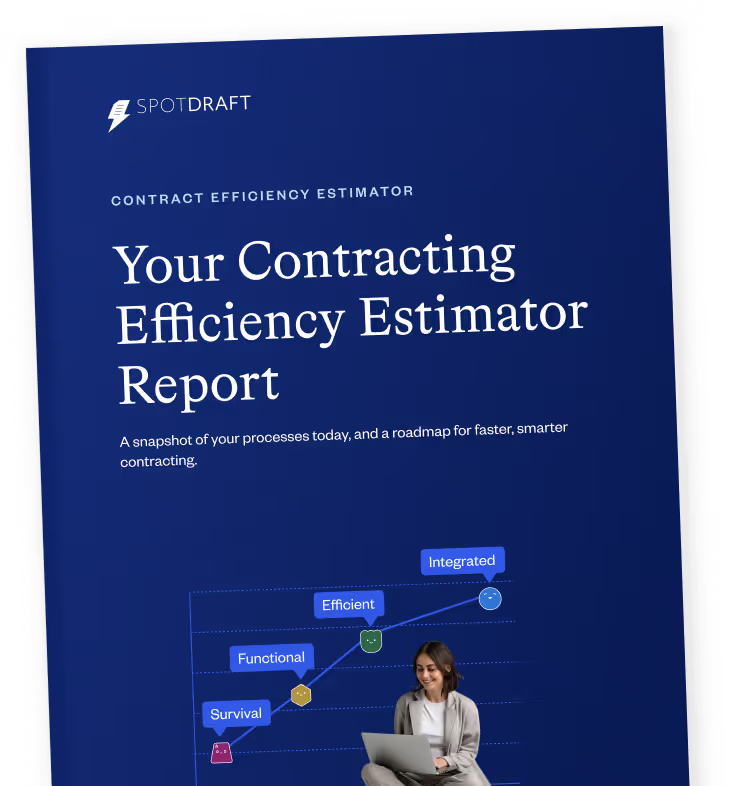There’s a popular saying in business: “If you can measure it, you can manage it.” This holds true even for legal teams in modern contract management, where legal contributions are directly tied to revenue.
Quantifying legal performance through contract analytics allows for better process optimization and improved contributions to the bottom line.
But here’s the problem:
Many legal professionals come from a non-data-oriented background, with a historical emphasis on qualitative contributions where value is often more abstract than tangible. So, they naturally don’t know what metrics to track or how to access the required data.
This often leads to them making decisions based on intuition and experience, potentially missing opportunities, and exposing their operations to avoidable risks.
Read on as we explore how to effectively measure legal performance, including best practices and standard metrics you can integrate into your contract analytics workflow.
Why measuring contract management performance is crucial for your legal team’s success
"If we could figure it out, I intuitively knew that KPIs could help buttress the narrative I wanted to tell about the legal department by showing numerically where the legal team was adding value to the company. Lastly, it was clear that KPIs could show me where there were potential problems that need watching or fixing. And that's all valuable information, regardless of how it comes about. So, I resigned myself – as all in-house lawyers likely must – that legal department KPIs are here to stay. So, let's talk KPIs."
~ Sterling Miller, CEO and Senior Counsel for Hilgers Graben PLLC
KPIs All In-House Legal Departments Should Track
Measuring the performance of legal teams not only provides insights into individual contributions but also sheds light on the overall effectiveness of the legal function within an organization.
Here, we go into detail on the various ways measuring performance can benefit your in-house legal department.
#1 Spotting and eliminating bottlenecks
“Try to glean as much info about what causes friction as possible. Your biggest wins will come from addressing these knowledge gaps or hesitancies that are blocking/slowing deals.” ~ Sue So, Head of Legal, Hopin
Streamlining Contracts in Hyper growth Startups
Contract analytics allows you to pinpoint the exact stages in the contract lifecycle where delays occur. This is achieved by exploring metrics like contract review time, negotiation cycles, and approval processes.
When you measure your legal team’s performance, you gain insights that enable targeted improvements. This ultimately speeds up contract turnaround times, improves stakeholder satisfaction, and arms your team with more bandwidth for higher-value contributions.
#2 Giving credit where it’s due
Recognizing and rewarding high performance is crucial for maintaining motivation and job satisfaction within the legal team.
By analyzing performance, you can accurately assess the contributions of individual team members. For instance, tracking metrics like the number of contracts reviewed, negotiated, or successfully closed can highlight top performers.
This ensures that recognition and rewards are based on objective performance rather than subjective opinions, fostering a culture of meritocracy. It also creates a feedback loop essential for continuous improvement and professional growth.
#3 Balancing workloads and optimizing resource allocation
Ever feel like some team members are swamped while others have a lighter workload? Contract analytics provides valuable insights into workload distribution, allowing you to identify imbalances and allocate resources more effectively.
If you understand the types of contracts each team member handles and their respective workloads, you can ensure everyone is working at optimal capacity, prevent burnout, and maximize productivity.
#4 Demonstrating the value of legal to stakeholders
“You need to tell stakeholders what your team is up to. Leverage tools such as CLMs to showcase how your team has contributed to closing deals effectively.”~ Juliette Thirsk, Head of Legal at Peach Payments
Streamlining Legal at a FinTech Startup
It’s an unpleasant reality, but traditional legal departments are often seen as cost centers rather than value drivers. Contract analytics changes that narrative by providing quantifiable evidence of the legal team's impact on the bottom line.
By tracking metrics such as cost savings achieved through negotiation, risk mitigation, contract review turnaround times, and contract compliance, you can showcase the tangible value legal brings to the organization. This strengthens the legal team's position within the company and justifies investments in technology and resources.
#5 Enhancing compliance and risk management
”You can either be part of the cleanup crew or do stuff to avoid that cleanup situation altogether."
~ Gitanjali Pinto Faleiro, General Counsel, Company Secretary & CCO at Greenhill & Co.
Navigating the C-Suite as a GC
Compliance and risk management are critical functions of any legal team, especially in contract management. Measuring your team's performance provides the opportunity to track how effective the team is in ensuring contracts meet regulatory requirements and internal policies.
Metrics such as the number of compliance issues identified, the frequency of contract disputes, and the time taken to resolve issues can provide insights into the team’s vigilance and effectiveness in mitigating risks.
Also read: How Contract Data Management Helps Maximize Legal Impact
Key metrics for tracking legal performance in contract management
Due to the qualitative nature of the traditional legal function, expressing the value of the legal team’s contributions in numbers used to be challenging, especially in contract management.
However, as modern business processes become more entwined with legal, the availability of data and sophisticated analytics tools has made it possible to quantify legal performance in a way that was previously unimaginable.
That said, there are several metrics that provide insight into legal contributions. You just have to choose and focus on the ones that are most relevant to your organization. Here are a few to consider:
Also Read: Why Contract Management KPIs Are Key to Legal Success
#1 Average time spent per lifecycle stage
This metric measures the average duration a contract spends in each phase of its lifecycle, from initial drafting to execution and beyond. Longer times in specific lifecycle stages often indicate the presence of bottlenecks and the need for process optimization.
For example, if your data shows that contracts spend an average of 10 days in the "Review/Approval" stage, but the benchmark is five days, you know there's a potential bottleneck. You can then investigate further to determine the cause of the delay and take corrective action.
#2 Contracts closed per month
This metric tracks the number of contracts successfully closed and executed each month. It provides insights into the legal team's productivity and workload management. A higher number of closed contracts can indicate a well-functioning team, while a lower number might highlight resource constraints or process inefficiencies.
Monitoring this metric helps in assessing the team's capacity and planning future workload distribution.
#3 Average contract closing time
Average contract closing time measures the total time taken from the initiation of a contract to its final execution. This includes all stages, from drafting to approval and signing.
A shorter closing time often signifies efficient processes, streamlined negotiations, and good alignment between parties. Monitoring this can help you identify areas for improvement and potentially accelerate your revenue cycle.
#4 Compliance rate
Compliance rate measures the percentage of contracts that adhere to internal policies, regulatory requirements, and external standards.
A high compliance rate indicates that the legal team is effectively ensuring that all contracts meet necessary guidelines, and the risk of legal issues or penalties is minimal.
#5 Average contract review turnaround time
This metric tracks the average time the legal team takes to review contracts, from when a contract is received for review to when it is returned with feedback or approval.
Faster turnaround times indicate the legal team is sufficiently fostering productive business operations and accelerating time-to-revenue.
Also read: How to Review a Contract Faster and More Efficiently
#6 Turnaround time by contract type
Not all contracts are created equal. This metric analyzes the turnaround time for different types of contracts, revealing potential patterns. For instance, you might find that sales contracts are consistently faster to finalize than complex procurement agreements.
This insight is crucial for effectively allocating resources and setting realistic expectations for different contract types.
#7 Dispute resolution time
Dispute resolution time measures the average duration taken to resolve disputes arising from contractual relationships. Several factors can impact how long a dispute resolution process takes, including the complexity of the issue, the amount of money involved, the willingness of disputing parties to renegotiate, and the availability of resources.
This metric reflects the legal team's ability to handle and resolve conflicts efficiently. A shorter resolution time generally indicates a well-organized legal team, effective communication strategies, and the ability to find amicable solutions quickly.
Also read: Finding Common Ground: How to Resolve Contract Disputes
Steps for measuring your legal team’s performance
Measuring legal performance, while undeniably crucial, is often a difficult task for many in-house counsel who know neither the right metrics to track nor how to access the required data.
But by following the steps discussed below, you’ll be on the right track.
#1 Get your Key Performance Indicators (KPIs) right
The first step in measuring your legal team's performance in contract management is to set the right KPIs. KPIs are essential metrics that help track and measure the team’s effectiveness and productivity.
Ensure your KPIs aren’t only relevant to your legal team but also aligned with your organization’s overall business objectives. Common metrics include average time spent per lifecycle stage, average contracts closed per month, and compliance rate (refer to the previous section).
“The biggest mistake most legal departments make, in my opinion, is trying to track too many KPIs.”
~ Sterling Miller, CEO and Senior Counsel for Hilgers Graben PLLC
KPIs All In-House Legal Departments Should Track
#2 Establish your benchmarks based on industry average and historical performances
Benchmarks provide a reference point where you draw parallels to measure your team's performance. Look at industry standards to understand where you stand in comparison to peers.
What's the average contract turnaround time in your sector? How many contracts do similar legal teams typically close per month? Simultaneously evaluate your team’s past performance to set realistic expectations that account for your team’s unique operational nuances.
Taking advantage of benchmarks allows you to get a well-rounded understanding of where your team excels and where they have room for improvement. It also ensures your targets are both ambitious and grounded in reality.
#3 Gather and activate data with a Contract Lifecycle Management (CLM) tool
To accurately track and measure your contract management KPIs, you need a robust system for collecting and analyzing contract data.
A CLM like SpotDraft is invaluable in this regard. First, it offers a central repository where you can securely unify all your contracts for easy access. Then, it offers a robust contract analytics tool fitted with dashboards, charts, and filters to help you quickly transform your data into actionable insights (more on this below).
This eliminates all the hassles associated with clunky spreadsheets and manual processes, offering you more productive access to insights.
#4 Schedule periodic evaluation and improvement on KPIs and analytical processes
Regular reviews are crucial to ensuring continuous performance enhancement. Set a consistent schedule for reviewing your KPIs. During these reviews, assess whether your team is meeting the established benchmarks and identify any deviations. Also, use these sessions to analyze the effectiveness of your analytical processes, making adjustments as needed to improve accuracy and relevance.
Consistently refining your metrics and processes allows you to maintain an agile and efficient system that continuously aligns with your organization’s changing conditions and objectives.
Accelerate time-to-insight with SpotDraft’s Contract Analytics
Contract Analytics is part of SpotDraft’s suite of contract management solutions. It is specifically designed to help legal and business teams efficiently uncover critical insights from their contract data.
With four dashboards and over 30 metrics out-of-the-box, Contract Analytics helps you capture a 360-degree view of your legal team's performance in crucial areas of your organization's contract management.
Also Read: Contract Management Dashboard: A Comprehensive Guide
The tool also comes with prebuilt charts that present key data in intuitive, visually engaging formats. This allows you to quickly grasp the implications of the metrics you’re exploring.

To facilitate targeted insights, Contract Analytics comes with robust filtering functionalities you can leverage to narrow your measurements down to a more granular level. For instance, you can filter contract data by date, contract type, users, and more.
That way, you can focus on insights that really matter to your team.
What’s next?
To stay competitive in the modern business environment, legal teams must learn to analyze and optimize their performance. This is particularly important in contract management, where legal contributions are tied to business outcomes.
By following the best practices discussed in this guide and utilizing SpotDraft's contract analytics tool, you can rest assured that your team's performance will maintain an upward trajectory.
So, what’s next?
Click here to get a personalized demo of Contract Analytics!


.avif)







